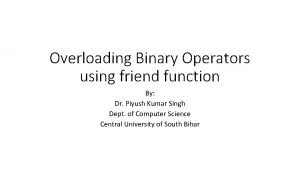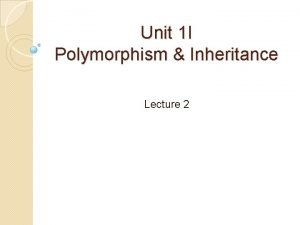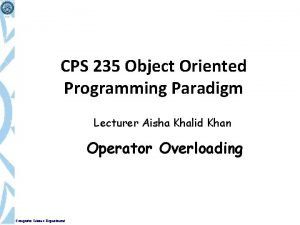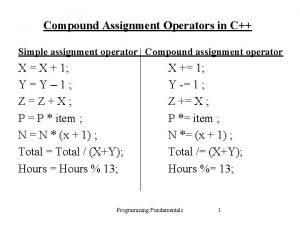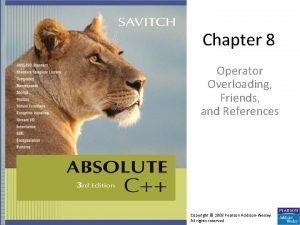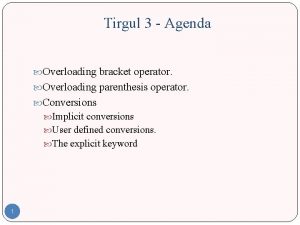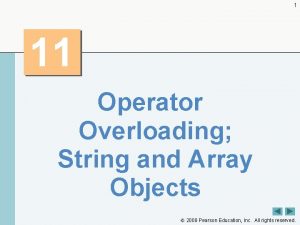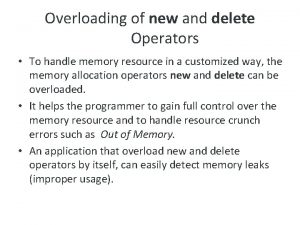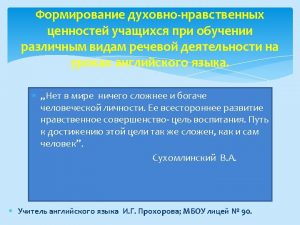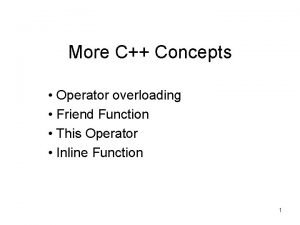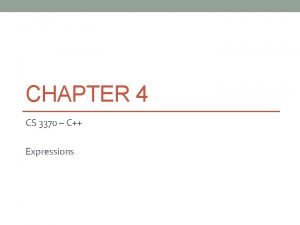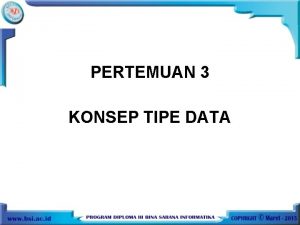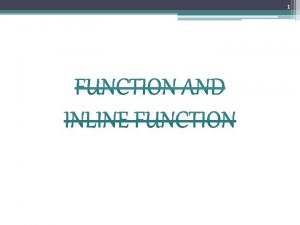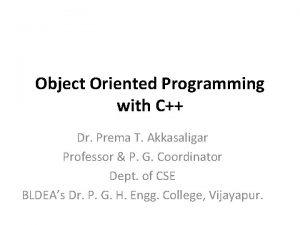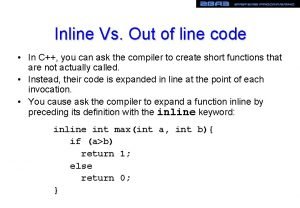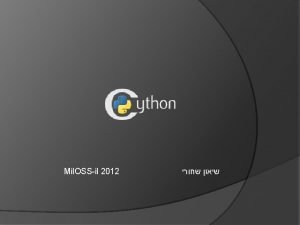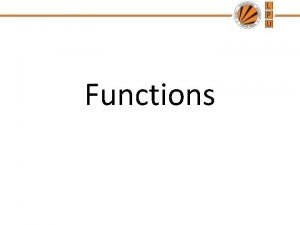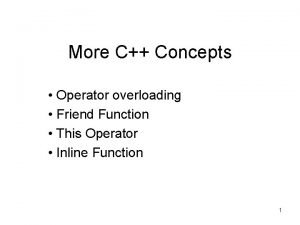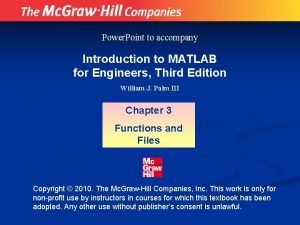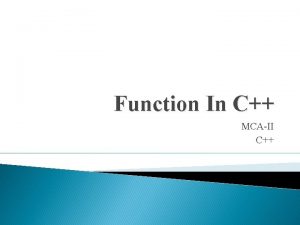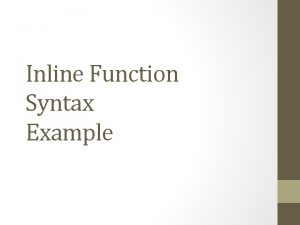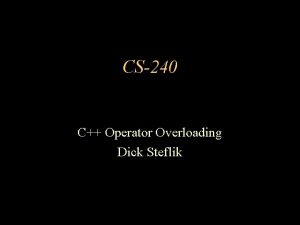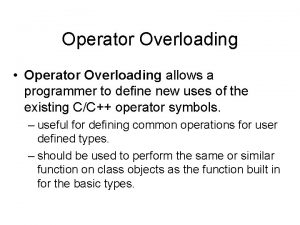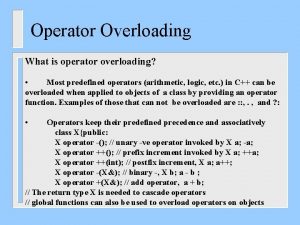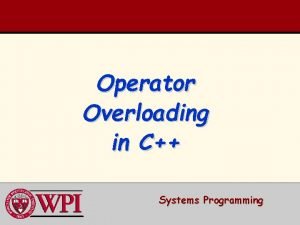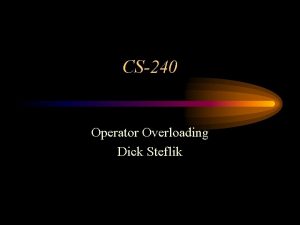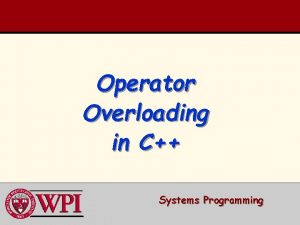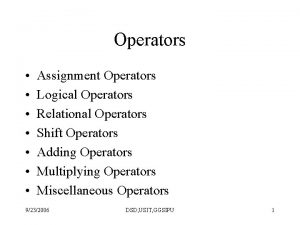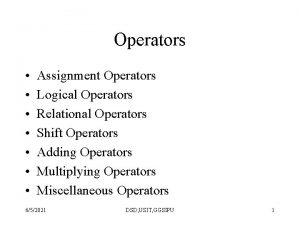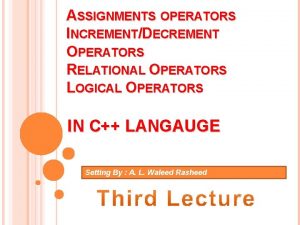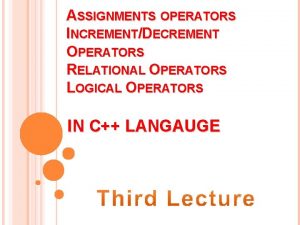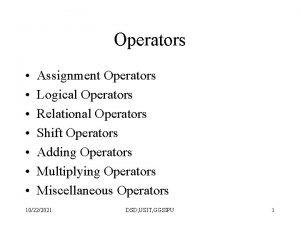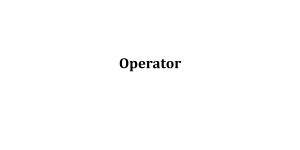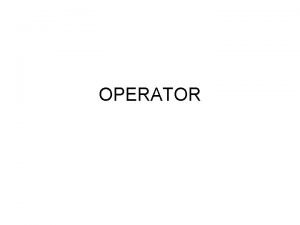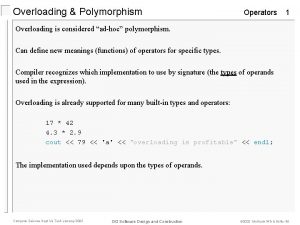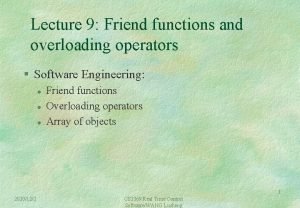Operator overloading Conversions friend inline Operator Overloading Operators








































- Slides: 40

Operator overloading Conversions friend inline.

Operator Overloading § Operators like +, - , * , are actually methods, methods and can be overloaded. § Syntactic sugar. §

What is it good for - 1 • Natural usage. • compare: • a. set( add(b, c) ) • to • a= b+c • compare: • v. element. At(i)= 3 • to v[i]= 3

What is it good for - 2 § § Semantic integrity. A rule of thumb: § When you need to make a deep copy of an object, you need to define all of these: 1. Copy constructor 2. Destructor 3. Operator = § Or in other words: when you need one, you need all.

What is it good for - 3 Uniformity with base types (important for templates) template<typename T> const T& min(const T& a, const T& b) { return a<b ? a : b; } a and b can be primitives or user defined objects that have operator <

Rules 1. Don't overload operators with non-standard behavior! (<< for adding, . . . ) 2. Check how operators work on primitives or in the standard library and give the same behavior in your class.

Example of usage in primitives/standard library § >> << are used as bit operations for primitives numbers and for I/O in the standard library iostreams classes. § [] is used as subscripting primitives arrays and vector class in the standard library § () is used for function calls and for functor objects in the standard library

Prototype X& operator=(const X& rval) return type method name parameter for object on right side of operator

Invoking an Overloaded Operator can be invoked as a member function: object 1. operator=(object 2); It can also be used in more conventional manner: object 1= object 2;

A skeleton for deep copy // Copy constructor A (const A& other) : init { copy_other(other); } // Destructor ~A() { clear(); } // Operator = A& operator=(const A& other) { if (this!=&other) { // preventing problems in a=a clear(); init // or recycle copy_other(other); } return *this; } // allows a= b= c= …

Int. Buffer example

C++-11 Move ctor and assignment // Move constructor A (const A&& other) { ? } // Move operator = A& operator=(const A&& other) { ? } http: //www. cprogramming. com/c++11/rvaluereferences-and-move-semantics-in-c++11. html

List & Complex examples

Operators ++ -- postfix prefix // Prefix: ++n HNum& operator++() { code that adds one to this HNum return *this; // return ref to curr } A flag that makes it postfix // Postfix : n++ const HNum operator++(int) { Hnum cpy(*this); // calling copy ctor code that adds one to this HNum return cpy; } 14

Operators ++ -- postfix prefix // Prefix: ++n HNum& operator++() { code that adds one to this HNum return *this; // return ref to curr } A flag that makes it postfix // Postfix : n++ const HNum operator++(int) { Hnum cpy(*this); // calling copy ctor code that adds one to this HNum return cpy; } // For HNum, it might be a good idea not 15 to

Conversions of types is done in two cases: 1. Explicit casting (we'll learn more about it in next lessons) 16

Conversions of types is done in two cases: 1. Explicit casting (we'll learn more about it in next lessons) 2. When a function gets X type while it was expecting to get Y type, and there is a casting from X to Y: void foo(Y y) y. . . X x; foo(x); // a conversion from X to Y is done 17

Conversion example (conv. cpp) 18

Conversions danger: unexpected behavior Buffer(size_t length) // ctor … void foo(const Buffer& v) // function. . . foo(3); // Equivalent to: foo(Buffer(3)) // Did the user really wanted this? The Buffer and the size_t objects are not logically the same objects! 19

Conversion example (conv_explicit. cpp) 20

User defined conversion class Fraction {. . . // double --> Fraction conversion Fraction (const double& d) {. . . }. . . // Fraction --> double conversion operator double() const {. . . } 21

friend 22

friend functions Friend function in a class: Not a method of the class Have access to the class’s private and protected data members Defined inside the class scope Used properly does not break encapsulation 23

friend functions example: Complex revisited 24

friend classes A class can allow other classes to access its private data members The friendship is one sided 25

friend classes - example class Int. Tree { … friend class Int. Tree. Iterator; }; // Tree. Iterator can access Tree's data members Int. Tree. Iterator& Int. Tree. Iterator: : operator++() {. . . return *this; } 26

Google test (not for your test) FRIEND_TEST(Test. Case. Name, Test. Name); Declares that this test will be able to test private methods of the class in which you write this 27

Inline functions / methods 28

Inline functions / methods A hint to a compiler to put function’s code inline, rather than perform a regular function call. When the compiler must produce an address of the function, it will always reject our request. • Objective: improve performance of small, frequently used functions. • An inline function defined in. cpp file is not recognized in other source files. • 29

C vs C++ : macro vs inlining compare: define SQRT(x) ((x)*(x)) SQRT(i++) // unexpected behavior to inline int sqrt(int x) { return x*x; } sqrt(i++) // good behavior 30

Inline methods You can hint to the compiler that a method is inline in class declaration (inside the { }; block of a class): class Tree {. . . size_t size() const{ // automatically hints on inline return _size; } }; 31

Inline methods You can hint to the compiler that a method is inline after class declaration: class Tree {. . . size_t size() const; . . . }; inline size_t Tree: : size() const { // still in the h file return _size; } 32

Tradeoffs: Inline vs. Regular Functions / Methods • Regular functions – when called, compiler stores return address of call, allocates memory for local variables, etc. 33

Tradeoffs: Inline vs. Regular Functions / Methods • Regular functions – when called, compiler stores return address of call, allocates memory for local variables, etc. • Inline functions – no function call overhead, hence usually faster execution (especially!) as the compiler will be able to optimize through the call ("procedural integration"). 34

Tradeoffs: Inline vs. Regular Functions / Methods • Regular functions – when called, compiler stores return address of call, allocates memory for local variables, etc. • Inline functions – no function call overhead, hence usually faster execution (especially!) as the compiler will be able to optimize through the call ("procedural integration"). • Inline functions - code is copied into program in place of call – can enlarge executable program 35

Tradeoffs: Inline vs. Regular Functions / Methods • Regular functions – when called, compiler stores return address of call, allocates memory for local variables, etc. • Inline functions – no function call overhead, hence usually faster execution (especially!) as the compiler will be able to optimize through the call ("procedural integration"). • Inline functions - code is copied into program in place of call – can enlarge executable program • Inline functions - can enlarge compile time. You compile the inline function again and again in every place it's used. 36

Tradeoffs: Inline vs. Regular Functions / Methods • Inline functions - less information hiding

Precompiled Headers • May save some compiling time • Not in this course

Link Time Optimization • Compilers might do inlining even for compiled functions (that were in. cpp files) • Not in this course, see discussion here: http: //stackoverflow. com/questions/7046547/link-timeoptimization-and-inline

Inline Constructors and Destructors may have hidden activities inside them since the class can contain sub-objects whose constructors and destructors must be called. You should consider its efficiency before making them inline.
 Binary operator overloading using friend function
Binary operator overloading using friend function Hello the sun is shining
Hello the sun is shining Hello my friend!
Hello my friend! Pitfalls of operator overloading in c++
Pitfalls of operator overloading in c++ Binary operator overloading in c++
Binary operator overloading in c++ Compound assignment operator
Compound assignment operator Unary operator overloading
Unary operator overloading Overload stream insertion operator c++ template
Overload stream insertion operator c++ template C++ bracket operator
C++ bracket operator Unary operator overloading in c++
Unary operator overloading in c++ Delete operator overloading in c++
Delete operator overloading in c++ Unary operator overloading
Unary operator overloading Let's be good friends you and i
Let's be good friends you and i Foaf friend of a friend
Foaf friend of a friend I've found a friend oh such a friend
I've found a friend oh such a friend A friend in needs a friend indeed
A friend in needs a friend indeed Friend operator
Friend operator Unary operator and binary operator
Unary operator and binary operator Tipe data int mempunyai ukuran
Tipe data int mempunyai ukuran Pada tipe data boolean, berlaku operator-operator...
Pada tipe data boolean, berlaku operator-operator... Logical operators priority in c
Logical operators priority in c Inline definition
Inline definition Double bastion inline
Double bastion inline Ich spiele inline-hockey
Ich spiele inline-hockey Numpy.polynomial.polynomial
Numpy.polynomial.polynomial Inline function matlab
Inline function matlab Data hiding in c++
Data hiding in c++ Inline hockey vs ice hockey
Inline hockey vs ice hockey Double bastion inline
Double bastion inline Inline function in c++
Inline function in c++ What is inline function
What is inline function Css inline vs external
Css inline vs external Cython inline
Cython inline Whats a function
Whats a function Inline function in c++
Inline function in c++ Inline pulsation dampener
Inline pulsation dampener Single bastion inline
Single bastion inline Inline function matlab
Inline function matlab What is inline function
What is inline function Inline coating
Inline coating Dreamweaver inline css
Dreamweaver inline css
